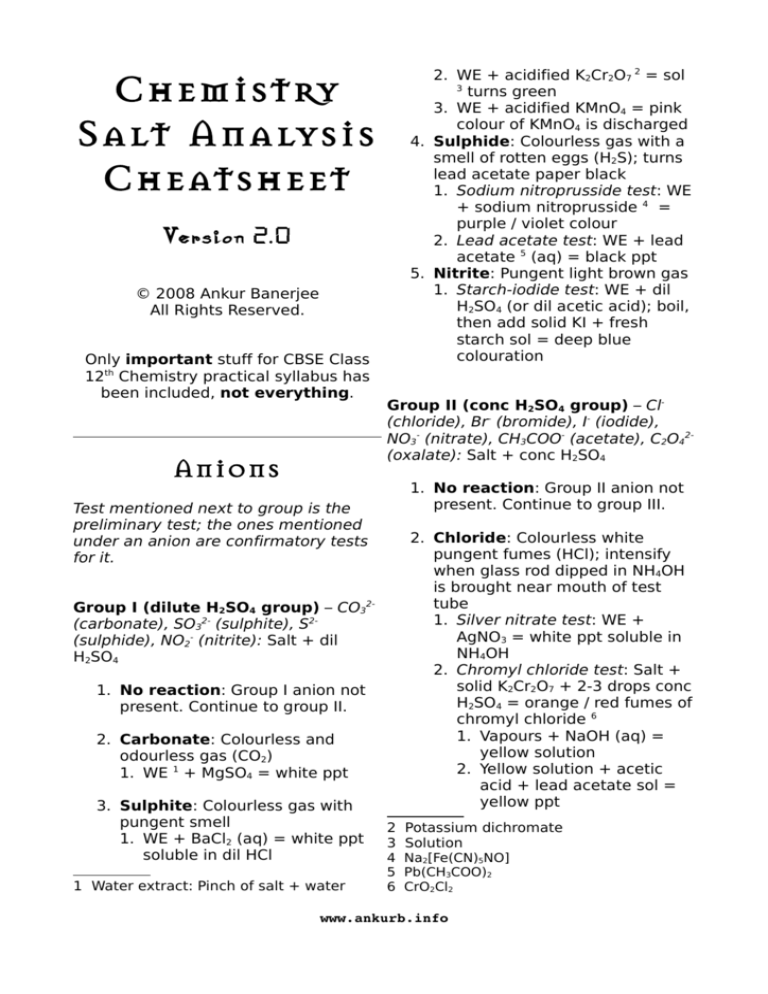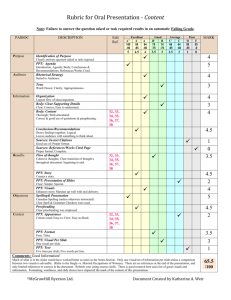
Chemistry
Salt Analysis
Cheatsheet
2. WE + acidified K2Cr2O7 2 = sol
3
turns green
3. WE + acidified KMnO4 = pink
colour of KMnO4 is discharged
4. Sulphide: Colourless gas with a
smell of rotten eggs (H2S); turns
lead acetate paper black
1. Sodium nitroprusside test: WE
+ sodium nitroprusside 4 =
purple / violet colour
2. Lead acetate test: WE + lead
acetate 5 (aq) = black ppt
5. Nitrite: Pungent light brown gas
1. Starch-iodide test: WE + dil
H2SO4 (or dil acetic acid); boil,
then add solid KI + fresh
starch sol = deep blue
colouration
Version 2.0
© 2008 Ankur Banerjee
All Rights Reserved.
Only important stuff for CBSE Class
12th Chemistry practical syllabus has
been included, not everything.
Anions
Group II (conc H2SO4 group) – Cl(chloride), Br- (bromide), I- (iodide),
NO3- (nitrate), CH3COO- (acetate), C2O42(oxalate): Salt + conc H2SO4
1. No reaction: Group II anion not
present. Continue to group III.
Test mentioned next to group is the
preliminary test; the ones mentioned
under an anion are confirmatory tests
for it.
2. Chloride: Colourless white
pungent fumes (HCl); intensify
when glass rod dipped in NH4OH
is brought near mouth of test
tube
1. Silver nitrate test: WE +
AgNO3 = white ppt soluble in
NH4OH
2. Chromyl chloride test: Salt +
solid K2Cr2O7 + 2-3 drops conc
H2SO4 = orange / red fumes of
chromyl chloride 6
1. Vapours + NaOH (aq) =
yellow solution
2. Yellow solution + acetic
acid + lead acetate sol =
yellow ppt
Group I (dilute H2SO4 group) – CO32(carbonate), SO32- (sulphite), S2(sulphide), NO2- (nitrite): Salt + dil
H2SO4
1. No reaction: Group I anion not
present. Continue to group II.
2. Carbonate: Colourless and
odourless gas (CO2)
1. WE 1 + MgSO4 = white ppt
3. Sulphite: Colourless gas with
pungent smell
1. WE + BaCl2 (aq) = white ppt
soluble in dil HCl
1 Water extract: Pinch of salt + water
2
3
4
5
6
Potassium dichromate
Solution
Na2[Fe(CN)5NO]
Pb(CH3COO)2
CrO2Cl2
www.ankurb.info
= white ppt; ppt dissolves
when dil HNO3 is added and
warmed
2. Potassium permanganate
test: Salt + dil H2SO4 + heat;
then add 2-3 drops KMnO4 sol
= pink colour of KMnO4 is
discharged
3. Bromide: Reddish brown vapour
1. Silver nitrate test: WE +
AgNO3 (aq) = yellow ppt
partially soluble in NH4OH
2. Organic layer test: WE + CCl4
+ 1 drop conc HNO3 = Upper
layer aqueous; lower layer
organic of orange / brown
colour (bromine is soluble in
Group III anions (special group) –
non-polar solvent)
SO42- (sulphate), PO43- (phosphate): No
group reagent
4. Iodide: Violet vapours
1. Silver nitrate test: WE +
1. Sulphate:
AgNO3 (aq) = yellow ppt
1. Barium chloride test: WE +
insoluble in NH4OH
BaCl2 (aq) = white ppt
2. Organic layer test: WE + CCl4
insoluble in conc HCl
+ 1 drop conc HNO3 = Upper
2. Lead acetate test: WE + lead
layer aqueous; lower layer
acetate (aq) + acetic acid =
organic of violet colour (iodine
white ppt soluble in
is soluble in non-polar solvent)
CH3COONH (ammonium
acetate)
5. Nitrate: Brown fumes with
pungent smell, which intensify on
2. Phosphate:
adding paper pellets (may need
1. Ammonium molybdate test:
heating)
WE + dil HNO3 + ammonium
1. Brown ring test: WE + freshly
molybdate 7 + boil =
prepared FeSO4 sol + 1 drop
crystalline canary yellow ppt
conc HNO3 added along side
of test tube = brown ring
formed at junction of sol and
acid
6. Acetate: Pungent vapour with
vinegar-like smell
1. Ester test: Salt + conc H2SO4
+ ethanol = fruity smell of
ester
2. Ferric chloride test: WE +
FeCl3 (aq) = brick red colour
1. Add dil HCl = red colour
disappears
2. Add water and boil =
reddish brown ppt
Cations
●
●
●
●
Group reagent is mentioned next
to group cations.
Test mentioned next to cation is
the preliminary; ones under it
are confirmatory tests for it.
When sulphate is detected, Ba2+,
Ca2+, Pb2+, and Sr2+ are not
present as sulphates of these
radicals are insoluble.
When phosphate is detected,
cations of group III and later are
absent.
7. Oxalate: Colourless gas with
effervescence (CO + CO2)
1. Calcium chloride test: WE +
acetic acid + CaCl2 (aq) + boil 7 (NH4)2MoO4
www.ankurb.info
Group 0 – NH4+ (ammonium): No
group reagent
1. Sodium hydroxide test: Salt +
NaOH = pungent smelling gas;
gives white fumes when a glass
rod dipped in conc HCl is brought
near mouth of test tube
2. Nessler's reagent 8 test: OS 9 +
NaOH + Nessler's reagent =
Brown / yellow ppt
Group I – Pb2+ (lead):
OS + dil HCl = white ppt; add water,
boil, and divide into three parts
1. Leave OS undisturbed = white
crystals formed on cooling
2. Potassium iodide test: OS + KI =
yellow ppt
3. Potassium chromate test: OS +
K2CrO4 = yellow ppt
Group II – Cu2+ (copper):
OS + dil HCl + H2S = black ppt
1. Throw off extra sol, retain ppt,
and dissolve in a few drops of
conc HNO3 = bluish green sol,
ppt dissolves; divide into two
parts
1. Part 1 + excess NH4OH = blue
coloured sol
2. Potassium ferrocyanide test:
Part 2 + acetic acid +
K4[Fe(CN)6] = reddish brown /
chocolate coloured ppt (Note –
this test is difficult to get)
Group III – Fe2+, Fe3+ (iron), Al3+
(aluminium):
OS + solid NH4Cl + excess NH4OH
1. Fe2+ / Fe3+: Note – ferrous salts
are green in colour, ferric salts
are brown in colour.
8 K2HgI4
9 Original solution: Salt + acid + water
1. If ferrous salt has been given,
convert to ferric: OS + conc
HNO3 + heat = brown ppt;
then do reaction with group
reagent
2. Brown ppt + HCl; then divide
into two parts
1. Potassium ferrocyanide
test: Part 1 + K4[Fe(CN)6] =
blue ppt / colour
2. Potassium thiocyanate
test: Part 2 + KCNS = blood
red colour
2. Al3+: Gelatinous white ppt
1. Blue lake test: Retain ppt + dil
HCl = clear sol
1. Sol + blue litmus and
NH4OH (drop-by-drop) =
blue colour layer ('lake')
floats over colourless sol
Group IV – Co2+ (cobalt), Ni2+ (nickel),
Mn2+ (manganese), Zn2+ (zinc):
OS + solid NH4Cl + excess NH4OH +
pass H2S gas
1. Co2+ / Ni2+: Black ppt; dissolve
ppt in aqua regia 10 and
evaporate sol to dryness to get
residue
1. Co2+: Blue residue; turns
pink / purple when dissolved
in water; divide into two parts
1. Part 1 + dil acetic acid +
KNO2 + warm = yellow ppt
2. Part 2 + ether (1 mL) +
solid NH4CNS 11 = blue
colour in ether
2. Ni2+: Yellow residue; turns
green when dissolved in
water; divide into two parts
10 Aqua regia: 3 parts conc HCl + 1 part
conc HNO3
11 Ammonium sulphocyanide
www.ankurb.info
1. DMG 12 test: Part 1 +
excess NH4OH + DMG =
bright red ppt
2. Part 2 + NaOH + bromine
water + boil = black ppt
2. Mn2+: Buff / skin colour ppt;
divide into two parts
1. Part 1 + dil HCl + boil off H2S
+ NaOH = white ppt; which
turns black / brown on adding
bromine water
2. Lead dioxide test: Part 2 +
PbO2 + conc HNO3 + boil =
after cooling; pink colouration
Group VI – Mg2+ (magnesium): No
group reagent
OS + NH4Cl + excess NH4OH +
ammonium phosphate = white ppt
Coloured salts
Colour
Inference
Blue
Cupric salts
Green
Hydrated nickel
salts
Rose red
Cobalt salts, HgI2
Light green
Ferrous salts
Yellow / brown
Ferric salts
3. Zn2+: Greyish white ppt; divide
Green / blue
Hydrated copper
into two parts
salts
1. Part 1 + excess NaOH = white
ppt dissolves
Deep blue
Anhydrous cobalt
2. Potassium ferrocyanide test:
salts
Part 2 + K4[Fe(CN)6] = white /
Pale pink
Manganese salts
bluish white ppt
Dark green /
Chromic salts
purple
Group V – Ba2+ (barium), Sr2+
(strontium), Ca2+ (calcium):
OS + (NH4)2CO3 + NH4Cl + NH4OH =
white ppt; add dil acetic acid, divide sol
into three parts and test for following
IN ORDER
1. Ba2+: Part 1 + excess K2CrO4 13
● With Br , most labs only have
(aq) = yellow ppt
NH4+.
2. Sr2+: Part 2 + (NH4)2SO4 (aq) =
2+
● With Ca , most labs only have
white ppt
Cl-.
3. Ca2+: Part 3 + (NH4)2C2O4 14 (aq)
● Easier way to do flame test: Use
+ NH4OH (only if nothing appears
test tube holder as tongs, and
at first) = white ppt
pick up a sizeable chunk of salt
4. Flame test: Take salt and make
with it. Put one drop of conc HCl,
a paste by mixing with conc HCl.
and put in Bunsen burner flame.
Take paste on tip of glass rod /
● Do flame test first; if you're lucky
platinum wire, and put in Bunsen
you'll get your cation early. Most
burner flame
2+
students spend up a lot of time
1. Ba : Green flame
doing cation test.
2. Sr2+: Crimson red flame
2+
3. Ca : Brick red flame
Miscellaneous Notes
12 Dimethyl glyoxime reagent
13 Potassium chromate
14 Ammonium oxalate
www.ankurb.info








